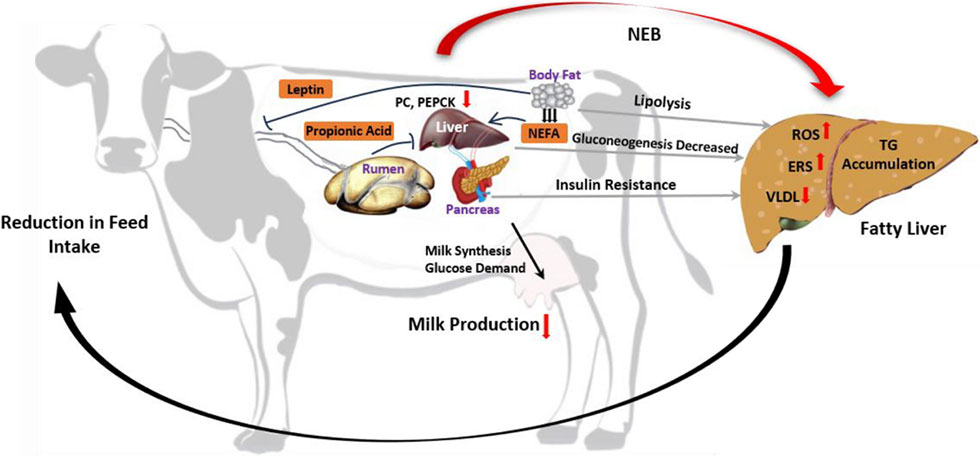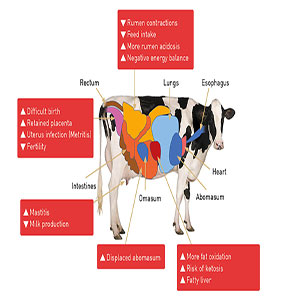Glucose Precursor Glycerol
Glucose Precursor Glycerol and Its Role in the Metabolism of Transition Cows
Introduction
The transition period—spanning the final weeks before calving through the early weeks of lactation—is a critical phase in dairy cow production. During this period, cows face dramatic changes in energy demands, nutrient partitioning, and metabolic status. One of the major challenges is maintaining an adequate supply of glucose, which is essential not only for energy balance but also for lactose synthesis and overall milk production. Given that ruminants derive only a small portion of dietary glucose directly (as most carbohydrates are fermented into volatile fatty acids in the rumen), gluconeogenesis becomes the key pathway to generate glucose in the liver. Among the substrates available for this pathway, glycerol has gained attention as an effective gluconeogenic precursor. Recent research shows that glycerol—a byproduct of biodiesel production—is increasingly used in transition cow diets to alleviate negative energy balance (NEB), support liver function, and help prevent ketosis. This article reviews the metabolic role of glycerol in transition cows, discussing its physiological impact, metabolism within the rumen and liver, and its potential to improve cow health during this critical phase.
The Transition Period in Dairy Cows
The transition period, typically defined as the three weeks before and three weeks after calving, is marked by significant physiological, hormonal, and metabolic changes. In late gestation, feed intake declines by as much as 30% even as energy demands increase to support fetal growth and prepare for lactation. Postpartum, cows often experience NEB, as milk production demands exceed available dietary energy. To meet these high energy requirements, cows mobilize body fat, leading to an increase in nonesterified fatty acids (NEFA) and the risk of ketosis.
Glucose is the most critical nutrient for milk synthesis. However, in ruminants, dietary carbohydrates are largely fermented in the rumen into volatile fatty acids (VFAs) such as acetate, propionate, and butyrate. Propionate serves as the primary precursor for gluconeogenesis, yet its conversion to glucose is energy‐intensive and dependent on enzyme activities that may be rate limiting during stress. Consequently, alternative substrates that can efficiently feed into the gluconeogenic pathway—such as glycerol—are of great interest to nutritionists and producers alike.
Glucose Metabolism and Gluconeogenesis in Transition Cows
Glucose plays a central role in lactation; it is not only the main substrate for lactose synthesis in the mammary gland but also essential for maintaining overall cellular energy balance. In ruminants, gluconeogenesis in the liver is the primary method of generating glucose, and it utilizes precursors including propionate, amino acids, lactate, and glycerol. Glycerol is noteworthy because it enters the gluconeogenic pathway at the level of dihydroxyacetone phosphate (DHAP) – a step that bypasses some of the regulatory bottlenecks seen with other substrates. This metabolic advantage means that glycerol can be converted to glucose with higher efficiency and lower energy cost.
During the transition period, the demand for glucose is accentuated by the sudden increase in milk synthesis and the relative decline in feed intake. As cows mobilize fat reserves, glycerol is released along with NEFAs from triglycerides stored in adipose tissue. This endogenous glycerol, coupled with glycerol provided in the diet, can help sustain hepatic gluconeogenesis and support energy balance. Furthermore, by reducing the reliance on fat mobilization, glycerol supplementation may help lower circulating NEFA concentrations and decrease the risk of ketosis.
Glycerol: A Gluconeogenic Precursor
Glycerol is a three‐carbon polyol traditionally known for its sweet taste, high water solubility, and viscous consistency. Originally recognized for its use in the pharmaceutical and cosmetic industries, glycerol has become more widely available as a byproduct of biodiesel production.
The key metabolic advantage of glycerol lies in its position in the gluconeogenic pathway. Once absorbed, glycerol is rapidly phosphorylated by glycerol kinase in the liver to form glycerol‐3‐phosphate. This intermediate is then oxidized to DHAP, which directly enters the gluconeogenic sequence. Because this pathway bypasses the rate‐limiting enzymes required for converting other substrates (such as propionate), glycerol is considered to be a highly efficient glucose precursor. This efficiency is particularly beneficial during periods when rapid glucose production is needed to counteract the effects of NEB.
Rumen Metabolism of Glycerol
Before glycerol is absorbed and utilized by the liver, it must first encounter the rumen environment, where a diverse microbial community ferments dietary substrates. Glycerol is known to be rapidly fermented by rumen microbes, and studies have shown that a significant portion of glycerol fed to cows is converted into VFAs—primarily propionate and butyrate—while a smaller fraction may escape ruminal fermentation to be absorbed intact.
The rate of glycerol disappearance from the rumen is high, with reports suggesting that over 80–85% of administered glycerol is either fermented or absorbed within 2 hours. While fermentation to propionate is beneficial in that propionate is a gluconeogenic substrate, excessive fermentation can limit the amount of glycerol available for direct absorption. Moreover, the conversion of glycerol to butyrate is of particular concern, as butyrate can be metabolized by the ruminal epithelium into beta‐hydroxybutyrate (BHBA), a ketone body that contributes to ketosis if present in excessive concentrations.

Glucose Precursors for ruminant
Hepatic Metabolism and Gluconeogenesis from Glycerol
Once glycerol reaches the liver—either in its absorbed form or as a residual fraction escaping rumen fermentation—it undergoes a series of enzymatic reactions to be converted into glucose. The process begins when glycerol kinase catalyzes the phosphorylation of glycerol to form glycerol‐3‐phosphate. This step is critical because it channels glycerol directly into the metabolic pathway that leads to DHAP. From DHAP, the substrate can be isomerized and eventually converted into glucose via the gluconeogenic pathway.
Because glycerol bypasses the earlier steps of gluconeogenesis that are required for converting substrates such as propionate, its use as a gluconeogenic precursor is both rapid and efficient. This efficiency can be particularly important in transition cows, where the sudden increase in milk production demands a swift response in glucose synthesis to prevent metabolic disorders. Moreover, by providing a readily available substrate for gluconeogenesis, dietary glycerol helps maintain blood glucose levels, thereby reducing the need for extensive mobilization of body fat. This reduction in fat mobilization not only protects liver health but also decreases the risk of ketosis—a condition that can be detrimental to cow health and lactational performance.
Role in Ketosis Prevention and Metabolic Health
Ketosis is a metabolic disorder characterized by elevated levels of ketone bodies (such as BHBA) in the blood, resulting from excessive fat mobilization in response to NEB. In transition cows, ketosis can lead to reduced milk yield, impaired reproductive performance, and even long-term health issues. Because the onset of ketosis is closely linked to insufficient glucose availability, enhancing gluconeogenesis during the transition period is a key strategy for prevention.
Glycerol supplementation has emerged as a promising approach for reducing the incidence of ketosis. By serving as a direct precursor to glucose, glycerol helps elevate blood glucose levels and reduces the need for the cow to break down body fat. Consequently, cows receiving glycerol supplementation tend to exhibit lower circulating NEFA and BHBA concentrations, markers that are strongly associated with ketosis. Moreover, studies have reported improvements in energy balance, feed intake, and even milk production when glycerol is incorporated into transition cow diets.
Potential Negative Effects of Excessive Glycerol
It is important to note that while moderate doses of glycerol are beneficial, using high amounts of glycerol—especially when fed in a non–rumen-protected form—can have negative metabolic effects. High doses lead to rapid fermentation in the rumen, shifting the fermentation profile toward increased production of butyrate. Since butyrate is a precursor to BHBA, an excessive conversion may elevate blood BHBA levels, thereby increasing the risk of ketosis. Research indicates that at higher doses, postpartum plasma glucose levels may decrease while BHBA levels rise, suggesting that over-supplementation of glycerol can be counterproductive. This underscores the importance of carefully managing both the amount and delivery method of glycerol to ensure that its benefits as a glucose precursor are realized without triggering adverse ketone body accumulation.
Practical Considerations for Glycerol Supplementation
Despite the promising metabolic benefits of glycerol, its successful incorporation into transition cow diets requires careful attention to several practical factors:
• Inclusion Rate and Dosing:
Studies suggest that glycerol can be included at levels up to 2–10% of dietary dry matter without adverse effects. However, very high inclusion rates may depress feed intake or alter rumen fermentation unfavorably. Gradual introduction of glycerol into the ration is recommended to allow rumen microbes to adapt, thereby minimizing the risk of acidosis.
• Delivery Method:
The route by which glycerol is provided can significantly affect its metabolic impact. Oral drenching tends to produce rapid increases in blood glucose, while mixing glycerol into a total mixed ration (TMR) can lead to more extensive ruminal fermentation. Rumen-protected formulations that allow glycerol to bypass fermentation in the rumen have demonstrated superior glucogenic effects and are an area of active development.
• Purity and Composition:
Commercial glycerol derived from biodiesel production may contain impurities such as methanol, salts, and residual fatty acids. It is critical to use glycerol of high purity (ideally >99% pure for metabolic studies or feed additives) or ensure that any impurities are within safe limits for animal consumption. Regulatory guidelines (e.g., methanol levels less than 150 ppm) should be followed to ensure safety.
• Economic Considerations:
As the biodiesel industry expands, glycerol is expected to remain a cost‐competitive feed ingredient. However, fluctuations in the market and processing costs may affect its economic viability. Producers must balance the potential benefits in animal performance and health against the cost of glycerol supplementation.
• Integration with Other Dietary Components:
Since glycerol can alter ruminal fermentation patterns (increasing propionate while potentially reducing acetate), its use should be integrated carefully with other feed ingredients to ensure that overall nutrient balance and fiber intake are maintained. This is particularly important for preserving milk fat synthesis and overall rumen health.
Conclusion
Glycerol represents a promising tool in the nutritional management of transition dairy cows. Acting as an efficient gluconeogenic precursor, glycerol helps sustain blood glucose levels during periods of negative energy balance, thereby reducing the risk of ketosis and supporting milk production. Although much of the dietary glycerol is subject to rapid ruminal fermentation, delivery methods that protect glycerol from premature microbial metabolism have shown superior metabolic benefits. Current research demonstrates that when incorporated at appropriate levels (typically up to 2–10% of dietary dry matter) and with careful attention to dosing and purity, glycerol can be a valuable alternative to traditional glucogenic precursors such as propionate and propylene glycol.
Importantly, using high amounts of glycerol—particularly when delivered in a non–rumen-protected form—can lead to rapid fermentation that favors butyrate production. Because butyrate is converted to BHBA in the rumen epithelium, excessive glycerol may raise blood BHBA levels and predispose cows to ketosis. Thus, while moderate glycerol supplementation improves energy balance and metabolic health, over-supplementation can have a negative effect.
Moreover, glycerol’s utility extends beyond metabolic support; its inclusion in transition cow diets can enhance feed efficiency, promote better liver health, and potentially improve reproductive performance and overall welfare. In an era when sustainable and cost-effective feeding strategies are increasingly important, repurposing glycerol—a byproduct of biodiesel production—offers both economic and environmental advantages. However, successful implementation requires careful formulation, monitoring, and adjustment based on herd conditions.


